The Setting Sun - Gotterdammerung, Japan 1944.
- Thread starter unmerged(59906)
- Start date
-
We have updated our Community Code of Conduct. Please read through the new rules for the forum that are an integral part of Paradox Interactive’s User Agreement.
You are using an out of date browser. It may not display this or other websites correctly.
You should upgrade or use an alternative browser.
You should upgrade or use an alternative browser.
I was going to recommend you move the subs from Attu Island, but then I figured it's probably better to leave them there as bait for the American CTFs. The AI seems fond of attacking the closest forces it can find.
Ouch! Not much else to say.
At least you destroyed several Allied units in return.
At least you destroyed several Allied units in return.
Wow, I was not aware that you have so many level 2 subs. I wanted to propose disbanding old subs (lvl 4) for some time anyway (even if they supposedly were acting as guards).
And now there is more than 3 MP less. Doh ...
Maybe disband those still existing before they are sunk ...
And now there is more than 3 MP less. Doh ...
Maybe disband those still existing before they are sunk ...
@ disbanding Subs
Maybe the most damadged ones?
Refilling them with manpower makes no senses, I think.
Maybe the most damadged ones?
Refilling them with manpower makes no senses, I think.
Maybe disband those still existing before they are sunk ...
While it makes sense, it sounds kinda cheap to me.
maybe disband the subs under the condition that you'll make a marine division out of that manpower.
While it makes sense, it sounds kinda cheap to me.
3MP means 3 interceptors or almost half of garrison. For sure reinforcing them does not make any sense.
EDIT: And I seriously doubt that Japan's goverment would put its troops in such circumstances into such equipment (Japan is definitively not loosing war, American fleets are not closing on home islands - they are not desperate). Such outdated ships would be scrapped IMO.
Last edited:
cosminus -Thank you, although I would prefer to update more frequently 
Beppo - Things are going more or less according to plan so far. My manpower situation is really atrocious given the territory I control but I chose not to 'fix it' and will continue as I am.
Air support for invasions is a tricky one. I have sixteen TAC squadrons doing Naval patrol and these could be used to support landings fairly easily. The only problem I have is an ethical one where I do not wish to commit any of these bombers to ground warfare roles as I have enough air power dedicated to that already. In reality a large number of bombers would be patrolling the oceans which is another reason I prefer not to use them for anything else. I will use them to support an invasion or bomb islands as these are Naval type attacks but whether I commit them inland after that is open to debate.
EnglandWarrior - If your definition of good is being attacked along a whole front by far superior numbers then I guess it is looking good
Nathan Madien - Kiev, Minsk and Smolensk are my main redeployment areas, so no I cannot afford to lose any of them. I only have to hold them until the second week of December to get all my redeploying troops on the map which is not too difficult given the weather conditions.
AdmiralNelson, zdlugasz, Hermann Steiner, Nathan Madien, gooy - Japan was actually pretty heavily into Submarines with many variants around for many different jobs. They would keep a Submarine fleet in my opinion even if it is outdated. Japan, of course, chose to ignore the more fundimental aspects of Anti Submarine Warfare but they did like Submarines. My remaining Submarines do have their uses even if it is only as bait for Calhoun. Remember these Submarines protected Pacific islands for over a year very successfully and I will not disband them even though, as you have pointed out, it makes good game sense to do so.
Maj. von Mauser - The only real problem I have is destroying Allied units faster than they can make them. The Soviets had the handicap on production which most of the smaller and medium sized Allied Countries do not. Germany is a prime example as it has amassed 100 divisions since the end of 1944.
Update to follow ...
Beppo - Things are going more or less according to plan so far. My manpower situation is really atrocious given the territory I control but I chose not to 'fix it' and will continue as I am.
Air support for invasions is a tricky one. I have sixteen TAC squadrons doing Naval patrol and these could be used to support landings fairly easily. The only problem I have is an ethical one where I do not wish to commit any of these bombers to ground warfare roles as I have enough air power dedicated to that already. In reality a large number of bombers would be patrolling the oceans which is another reason I prefer not to use them for anything else. I will use them to support an invasion or bomb islands as these are Naval type attacks but whether I commit them inland after that is open to debate.
EnglandWarrior - If your definition of good is being attacked along a whole front by far superior numbers then I guess it is looking good
Nathan Madien - Kiev, Minsk and Smolensk are my main redeployment areas, so no I cannot afford to lose any of them. I only have to hold them until the second week of December to get all my redeploying troops on the map which is not too difficult given the weather conditions.
AdmiralNelson, zdlugasz, Hermann Steiner, Nathan Madien, gooy - Japan was actually pretty heavily into Submarines with many variants around for many different jobs. They would keep a Submarine fleet in my opinion even if it is outdated. Japan, of course, chose to ignore the more fundimental aspects of Anti Submarine Warfare but they did like Submarines. My remaining Submarines do have their uses even if it is only as bait for Calhoun. Remember these Submarines protected Pacific islands for over a year very successfully and I will not disband them even though, as you have pointed out, it makes good game sense to do so.
Maj. von Mauser - The only real problem I have is destroying Allied units faster than they can make them. The Soviets had the handicap on production which most of the smaller and medium sized Allied Countries do not. Germany is a prime example as it has amassed 100 divisions since the end of 1944.
Update to follow ...
Operation Influx
9
9
0200 November 11th 1948.
Central Asia Army Headquarters. Sevastopol, Soviet Union.
The Japanese northern defences were weaker than those in the south, a fact that had not escaped the Allied Commanders.
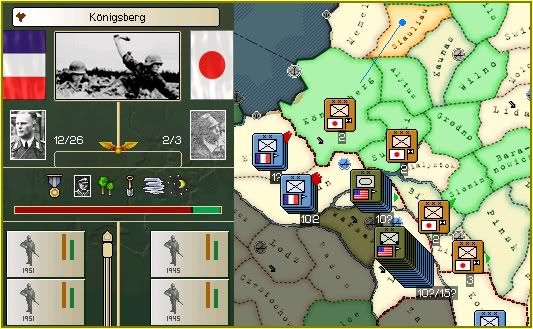
Lt. General Ito was ordered to abandon Konigsberg by Hata after he came under attack by twelve Allied divisions. Only Suwalki remained in the north as all of the other Japanese forces were withdrawing in the face of overwhelming odds.
0300 November 11th 1948.
BB Division 1 Flagship. IJN Fuso, Mouth of the Tsiribihina.
Ozawa had positioned his Battlefleet in the narrow channel between Madagascar and Africa where he could block any Allied shipping from moving north to harass the Japanese rear areas.
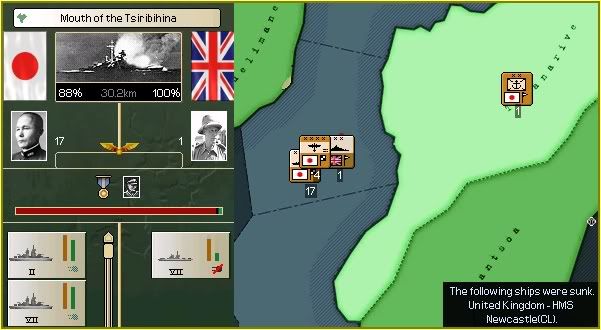
Patrolling bombers provided accurate reports on the movement of a British Light Cruiser through the Mouth of the Tsiribihina which allowed Ozawa to intercept HMS Newcastle. The guns of IJN Fuso sent the cruiser to the bottom.
1100 November 12th 1948.
Central Asia Army Headquarters. Sevastopol, Soviet Union.
Japanese Interceptors had needed a rest period after early engagements had depleted their numbers and organisation. By November 12th they were adequately repaired and were able to begin the task of disputing air superiority over the Western Front.
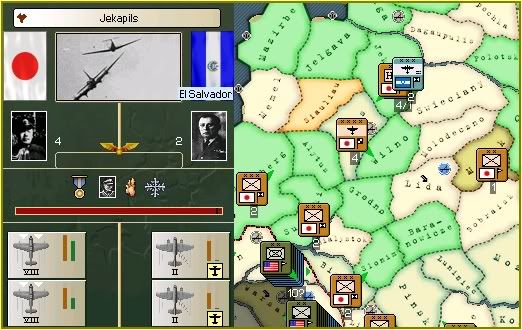
Field Marshall Higashikuni's Headquarters had been making good progress south and was close to its destination of Kaunas when it came under attack by Tactical bombers from El Salvador, which had moved north after failing to damage Hata's Headquarters in Sevastopol. Fukudome's Interceptor wing caught them over Jekapils as they attempted to bomb their target. Neither bomber squadron survived the interception.
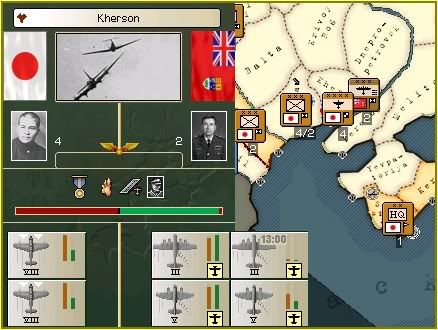
An hour later, at 1100 hours, Fukui's wing intercepted two Canadian bomber squadrons which were bombing the industry in Kherson. The Strategic bomber squadron was almost destroyed in the first hour of the dogfight which ensued. Fukui possessed the most experienced Interceptor wing in the Japanese Airforce and they had little trouble shooting down both Canadian squadrons.
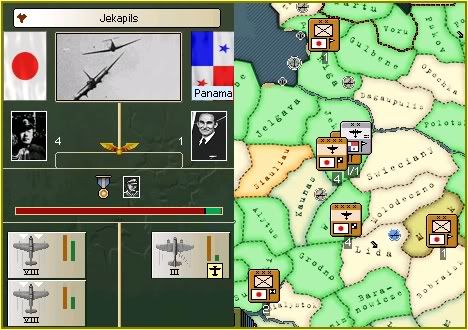
Another attack against Higashikuni's Headquarters was intercepted at 1000 hours on the 13th with Fukudome shooting down a Panamanian Tactical bomber squadron on this occasion.
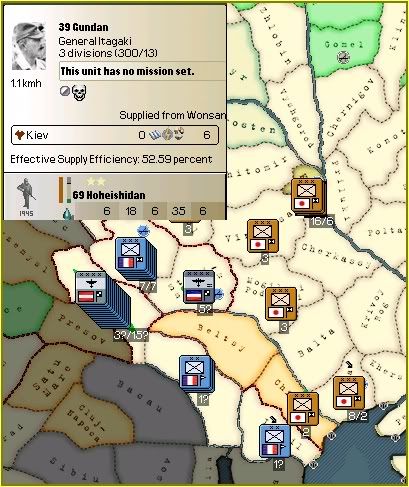
Hata's southern forces received their first reinforcements on November 14th with the arrival of General Itagaki in Kiev. This part of the line was in good condition with tactical withdraws keeping the line intact and only minimal enemy forces advancing. Enemy troops were concentrating around Lvov and the speed of the withdraw from Romania had opened up a gap between the opposing armies.
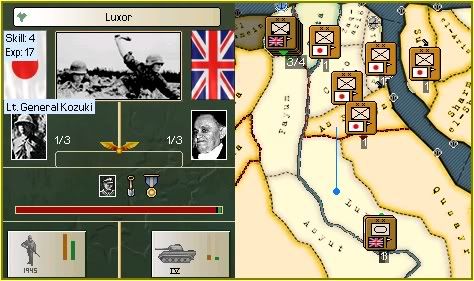
Itabana's bombers required some ground assistance in North Africa after the Brazilian Armoured division had managed to entrench in Luxor. Lt. General Kozuki forced the weakened Armoured division to retreat after Itabana had destroyed it's organisation which allowed it to be destroyed by ground attack on November 15th.
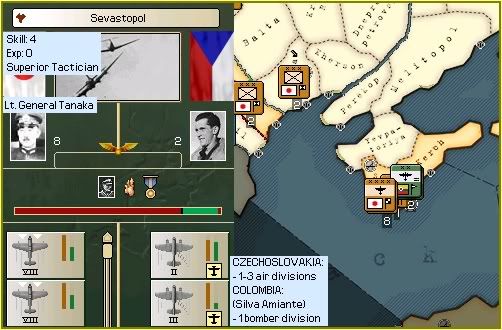
Attacks continued against Hata's Headquarters in Sevastopol but not with the previous ferocity. Tanaka had been paired with Fukui to form an Interceptor group and they intercepted the Czech and Columbian Tactical bomber squadrons that were harassing Hata. In similar fashion to other air combat between Japanese Interceptors and third World bombers both enemy squadrons were destroyed.
Last edited:
0800 November 16th 1948.
BC Division 1 Flagship. IJN Haruna, Southwest Madagascar Basin.
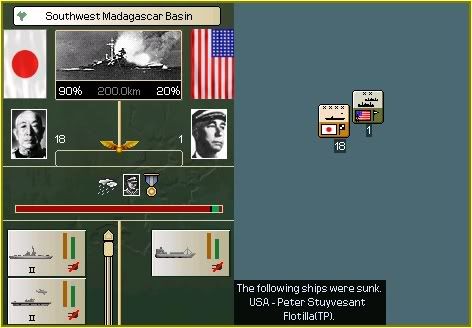
1000 November 17th 1948.
Central Asia Army Headquarters. Sevastopol, Soviet Union.
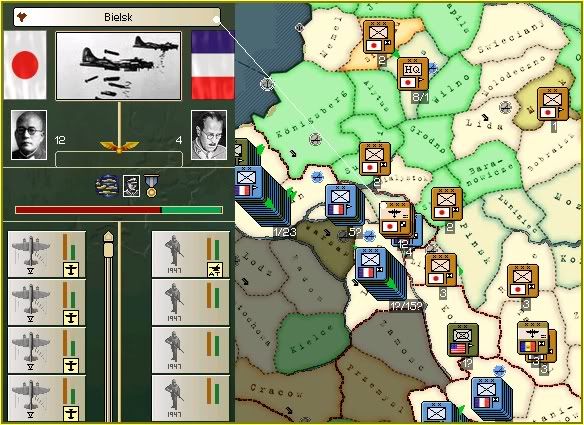
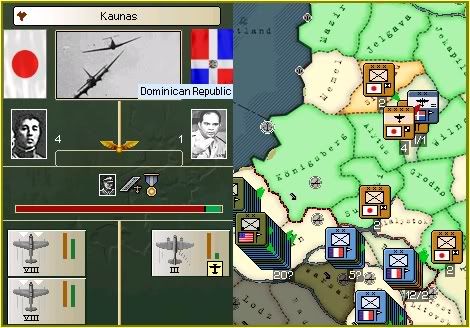
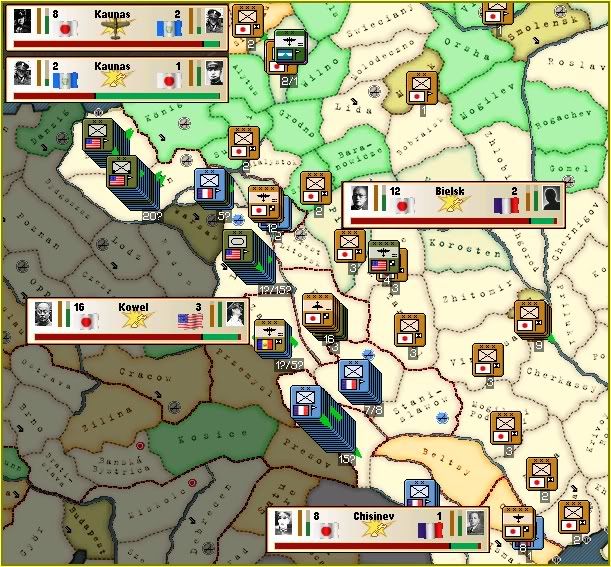
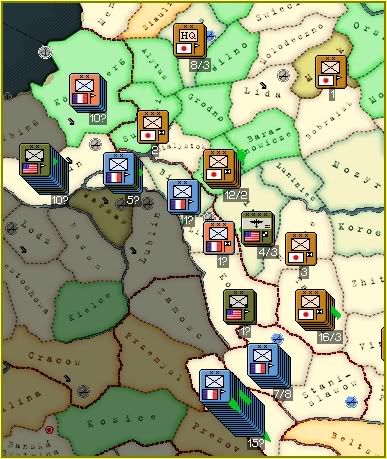
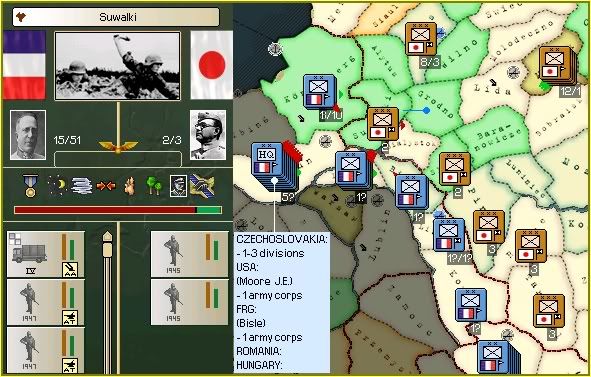
BC Division 1 Flagship. IJN Haruna, Southwest Madagascar Basin.
An American Transport Flotilla was spotted as it approached Reunion Island by Admiral Koga's BC Division 1 which had been stationed off the coast of the island to provide support to Mj. General Banzai's Marines.

Koga would never know if the American Admiral was more surprised by the presence of Marines on the island or the sight of his ships being destroyed by fourteen inch shells from the six Battlecruisers of BC Division 1. IJN Haruna, Koga's Flagship, would be credited with the kill.
1000 November 17th 1948.
Central Asia Army Headquarters. Sevastopol, Soviet Union.
More Allied advances had taken place as November passed it's mid-point. The pace of Allied progress had slowed considerably as Winter took a firm grip on proceedings with advances in the south also suffering from bad infrastructure after Obata's Tactical bombers had targetted the road and rail systems.

The arrival of French controlled Hungarian troops in the marshes of Bielsk saw Obata re-tasked to conduct ground attack missions against the province. His bombers were operating close to Allied airfields and they were provided with an Interceptor escort from Mj. General Saboru.

The Allies tried to bomb Higashikuni's Headquarters again on November 19th after it had reached Kaunas. This time it would be Watanabe who intercepted the bombers with predictable results.

Hata's air controller was one of the busiest people at his Headquarters as he not only had to order Japanese aircraft to attack and intercept but also had to monitor enemy aircraft movements. November 20th was not unlike most other days where there were a large number of aircraft flying from both sides.
Allied bombers were concentrating their Strategic efforts on Rowne and Tarnopol as well as towards Higashikuni's Headquarters. The skies were carefully watched to avoid any possible interception of Japanese bombers, which had led to some raids being abandoned already, and with some airfields becoming non-operational due to enemy fighter cover.
Every single Japanese squadron designated for this theater was in the air today. In the north Fukudome and Watanabe, operating as an air group, were intercepting enemy bombers trying to destroy Higashikuni's Headquarters. They would destroy both enemy squadrons.
Further south Obata continued his attacks against Bielsk with support from Saboru's Interceptor wing as the combined two Close Air Support groups targetted fresh enemy divisions that had arrived in Kowel. These sixteen squadrons provided the majority of the offensive air power at Hata's disposal and they were proving to be extremely potent.
In the south Tanaka and Fukui had begun ground attacks against a Romanian division that had advanced into Chisinev. Hata was deliberately avoiding trying to intercept enemy bombers that were any great distance from Japanese airbases as he wished to more or less guarantee a two wing interception against the more modern American or British bombers.
Allied bombers were concentrating their Strategic efforts on Rowne and Tarnopol as well as towards Higashikuni's Headquarters. The skies were carefully watched to avoid any possible interception of Japanese bombers, which had led to some raids being abandoned already, and with some airfields becoming non-operational due to enemy fighter cover.
Every single Japanese squadron designated for this theater was in the air today. In the north Fukudome and Watanabe, operating as an air group, were intercepting enemy bombers trying to destroy Higashikuni's Headquarters. They would destroy both enemy squadrons.
Further south Obata continued his attacks against Bielsk with support from Saboru's Interceptor wing as the combined two Close Air Support groups targetted fresh enemy divisions that had arrived in Kowel. These sixteen squadrons provided the majority of the offensive air power at Hata's disposal and they were proving to be extremely potent.
In the south Tanaka and Fukui had begun ground attacks against a Romanian division that had advanced into Chisinev. Hata was deliberately avoiding trying to intercept enemy bombers that were any great distance from Japanese airbases as he wished to more or less guarantee a two wing interception against the more modern American or British bombers.

The Japanese bombers could not be everywhere and there were far too many targets for them to prosecute for the time being which allowed the Allied to continue their advance. At 1300 hours on November 20th Allied troops occupied both Konigsberg and Brest Litovsk which gained them two forward airbases. This part of Poland and western Russia had no shortage of such bases which had been constructed and improved during the War.

Chandra Bose was forced to abandon Suwalki at 0300 hours on November 22nd after he was assaulted from three sides by fifteen Allied divisions. He withdrew towards Grodno which left even more gaps in the Japanese northern lines. The Allied Army contained a myriad of different Nationalities with Torun currently occupied by troops from five different Countries.
That gap between the lines in the south should give your tactical bombers lots of targets.
Once your army is in europe will you try and hold the line like you did with the Sovjets in China? Because that was the best part of your AAR so far. Would really like a sequel...
I'm starting to doubt Hata's dedication to the Japanese cause. What became of glorious chrges followed by glorious death for the Emperor? Withdrawing just doesn't seem to be the proper Japanese way of winning wars.
Thankfully all troops will soon be frozen stiff so then won't have any other option but to hold the line.
Thankfully all troops will soon be frozen stiff so then won't have any other option but to hold the line.
As always another good update.
Two grammatical errors were noted however. The first is in the 1100 November 12th 1948 section after the first picture there is the sentence, "Field Marshall Higashikuni's Headquarters had been making good progress south and was close to it's destination of Kaunas when it came under attack by Tactical bombers from El Salvador, which had moved north after failing to damage Hata's Headquarters in Sevastopol." The word "it's" should not have an apostrophe as it is denoting ownership or possession of the subsequent word. If you were using the term as a contraction then having the apostrophe would be correct. This is just another instance of an odd exception to the rule in English grammar.
The second is in the same section as the first although it is in the paragraph just above the second to last picture. In the sentence, "This part of the line was in good condition with tactical withdraws keeping the line in tact and only minimal enemy forces advancing", the words 'in' and 'tact' should have been joined to form the single word 'intact'.
Two grammatical errors were noted however. The first is in the 1100 November 12th 1948 section after the first picture there is the sentence, "Field Marshall Higashikuni's Headquarters had been making good progress south and was close to it's destination of Kaunas when it came under attack by Tactical bombers from El Salvador, which had moved north after failing to damage Hata's Headquarters in Sevastopol." The word "it's" should not have an apostrophe as it is denoting ownership or possession of the subsequent word. If you were using the term as a contraction then having the apostrophe would be correct. This is just another instance of an odd exception to the rule in English grammar.
The second is in the same section as the first although it is in the paragraph just above the second to last picture. In the sentence, "This part of the line was in good condition with tactical withdraws keeping the line in tact and only minimal enemy forces advancing", the words 'in' and 'tact' should have been joined to form the single word 'intact'.
I'm starting to doubt Hata's dedication to the Japanese cause. What became of glorious charges followed by glorious death for the Emperor? Withdrawing just doesn't seem to be the proper Japanese way of winning wars.
Thankfully all troops will soon be frozen stiff so then won't have any other option but to hold the line.
Thankfully all troops will soon be frozen stiff so then won't have any other option but to hold the line.
Give Remble time, he'll clear things up.
I wonder if he has destroyed all the Central American Bombers yet.
I wonder if he has destroyed all the Central American Bombers yet.
serutan - Welcome to the boards and this AAR  My bombers have a lot of targets for sure.
My bombers have a lot of targets for sure.
Middelkerke - I would expect a similar pattern to the Soviets. Make a line I can hold, grind down the enemy, counter attack, destroy.
EnglandWarrior - Indeed
MCG_Man - Thank you. Both fixed
Sokraates - Hata would not be a very well read man if he ignored Sun Tzu. Do not fight unless you know you can win
Maj. von Mauser - Not yet, the South and Central American Countries seem to have a lot of bombers.
Update to conclude November (only one page) ...
Middelkerke - I would expect a similar pattern to the Soviets. Make a line I can hold, grind down the enemy, counter attack, destroy.
EnglandWarrior - Indeed
MCG_Man - Thank you. Both fixed
Sokraates - Hata would not be a very well read man if he ignored Sun Tzu. Do not fight unless you know you can win
Maj. von Mauser - Not yet, the South and Central American Countries seem to have a lot of bombers.
Update to conclude November (only one page) ...
Operation Influx
10
1000 November 22nd 1948.
Central Asia Army Headquarters. Sevastopol, Soviet Union.
The pace of the air War continued to increase as more modern and escorted Strategic bombers began targetting Japanese front line airfields and industry.
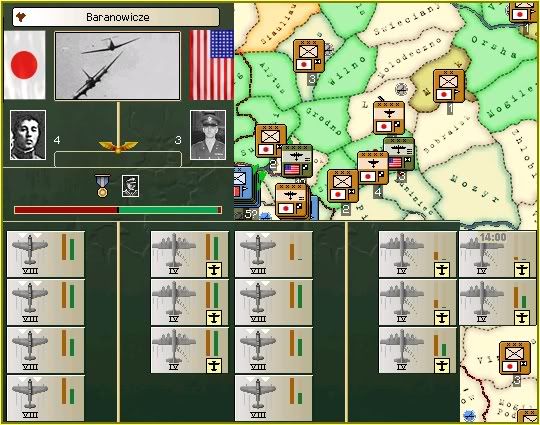
Watanabe intercepted a three squadron American Strategic bomber wing over Baranowicze but would not be joined by Fukudome during the dogfight. One of Watanabe's squadrons took excessive damage during the encounter but two of the American squadrons were destroyed during the four hour battle.

In the south Tanaka and Fukui strafed two Hungarian divisions in Beltsy causing minimal damage.
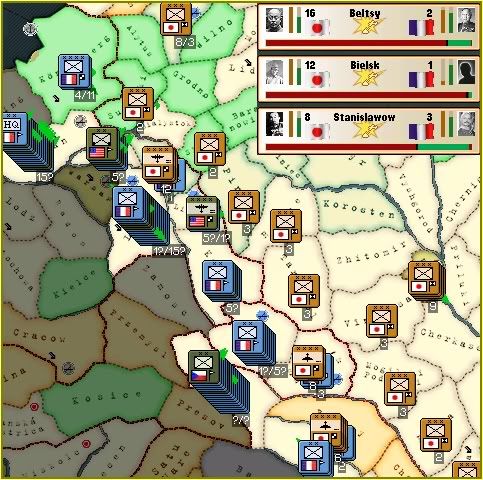
Japanese strike aircraft were re-arranged on November 23rd with Saboru continuing to escort the Tactical bombers as they bombed Bielsk with Shimoyama attacking Stanislawow without any escort. Nakajima joined Tanaka to attack Beltsy with his Dive bombers causing much more damage.
1200 November 23rd 1948.
BC Division 1 Flagship. IJN Haruna, Southwest Madagascar Basin.
Koga's presence off Reunion Island was proving to be profitable for the Imperial Japanese Navy as BC Division 1 intercepted another Transport fleet.

Admiral Sprague would lose both the Light Cruiser USS Honolulu and his Transport Division after four hours of gunfire. The Battlecruiser IJN Ikoma would claim both.
0500 November 25th 1948.
North China Army Headquarters. Kaunas, Lithuania.
Higashikuni had little offensive front to command with Hata taking charge of the main western line which relegated Higashikuni to Finland and the northern Soviet Union. Allied invasions had ceased in the Pacific a long time ago and had also been halted in and around the Indian Ocean with the Americans in particular suffering large losses. The Mediterranean landings had also stopped which left the Allies with Transport capacity not being used for much other than harassing Reunion Island in the Indian Ocean.
Higashikuni was a little surprised to learn of an invasion in his area of operations as American troops landed in Finland.
Higashikuni was a little surprised to learn of an invasion in his area of operations as American troops landed in Finland.
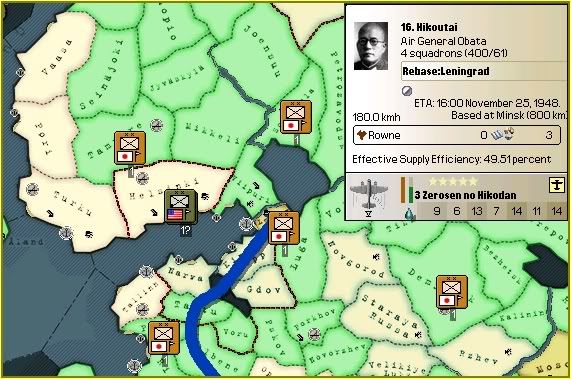
They had taken Helsinki, the former Finnish capital, with what looked to be two Motorised divisions. Obata's Tactical bomber group headed north to Leningrad to find out the composition of the enemy force and to begin attacks against them. The Allied invasion was a little worrying as the Japanese High Command had not thought that the Allies would operate in the Baltic. More troops would be required to defend an expanded coastline but none would be forthcoming. The Imperial Japanese Army was too thinly spread to send more divisions north and would concentrate on the main front line.
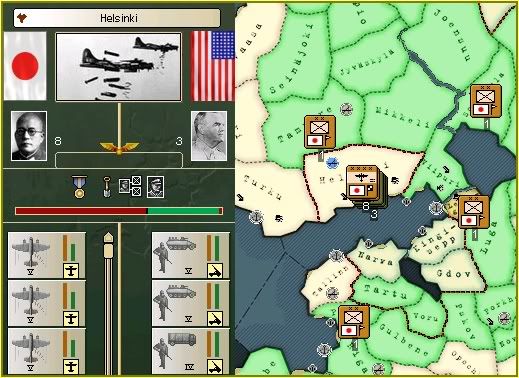
Obata arrived over Helsinki at 0700 hours on November 26th to find that a third American division had arrived overnight and two of the defenders were actually Mechanised forces. Should the invasion expand much further then a Close Air Support group would be needed to destroy the more armoured force that had landed.
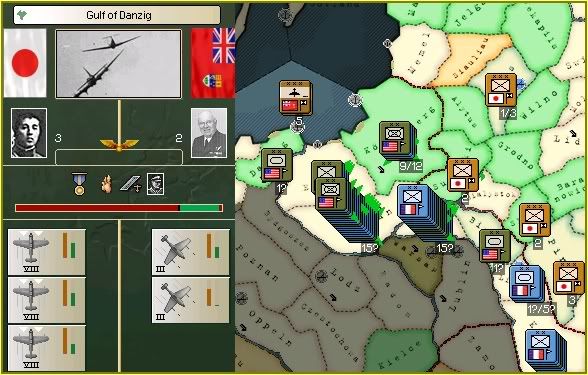
Air combat continued to erupt all along the western Front as more Allied aircraft began to seek out targets of opportunity. The highest priority for all Japanese Interceptor squadrons was enemy Dive bombers and two Canadian squadrons had targetted Japanese ground troops on November 25th. Watanabe, now only using three squadrons as one repaired, intercepted the Canadians as they tried to approach their target by sea on November 26th. Neither would be shot down but they would need a large amount of time to conduct repairs before they could return.

A full British Strategic bomber wing attacked the airbase in Minsk at 1200 hours on November 26th resulting in Saboru scrambling his Interceptors to try and reduce any damage to his airfield. He would only engage for two hours after his squadrons began to take unacceptable losses. Two Japanese wings were required to seriously damage the main Allied Strategic bomber forces with a few exceptions.
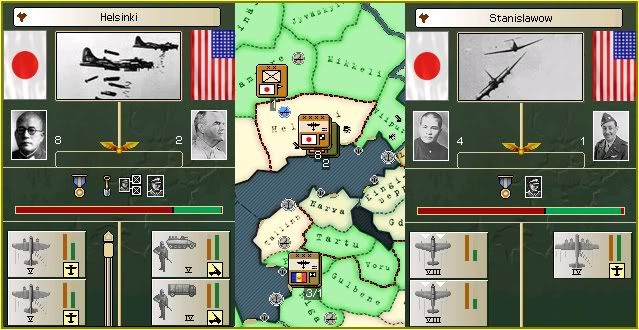
One such exception was Mj. General Fukui whose pilots could handle any even battle with relative ease. The interception of only a single American bomber squadron over Stanislawow led to its destruction. In Helsinki one of the three invading divisions had been destroyed by Obata and no further reinforcements had arrived by November 28th.
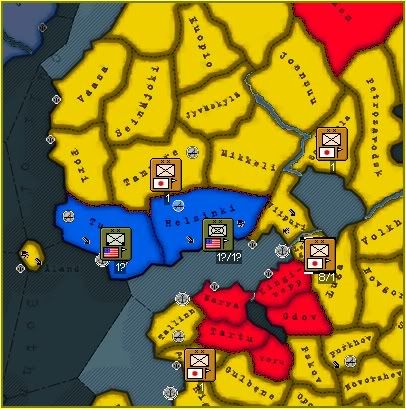
The Americans expanded their beach head on November 29th as they captured Turku. The Allies were demonstrating a clear willingness to launch invasions around the Japanese flanks after already landing in Odessa and now in Finland. Japanese planners would have to take this into account as they made decisions on future operations. The forces for the next operation had mustered in Ahmadabad and would set sail after a brief rest period. All Japanese reinforcements had arrived on the Western Front except for the Armour, which was due in the next two weeks.

